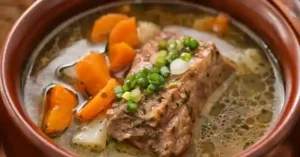Introduction to Chicken Bone Broth Crock Pot Recipe
Chicken bone broth is warm, comforting, and packed with nutrition. Making it in a crock pot is simple and hands-off. With just a few basic ingredients, you can create a rich broth that boosts flavor and health. This guide will show you the best bones to use, easy step-by-step instructions, and tips for perfect results. Keep reading to learn how to make your own chicken bone broth at home.

What Is Chicken Bone Broth?
Chicken bone broth is a nutrient-rich liquid made by simmering chicken bones, water, vegetables, and seasonings for several hours. Unlike regular chicken broth, which is often made with meat and cooked for a shorter time, bone broth focuses on extracting minerals, collagen, and amino acids from the bones themselves. The longer cooking process allows the broth to become richer in flavor and more nourishing.
Many people confuse chicken stock, broth, and bone broth. Here’s the difference:
- Chicken Broth: Usually made by simmering meat (like chicken breasts or thighs) with some vegetables and seasonings. It has a lighter flavor and shorter cook time.
- Chicken Stock: Typically made from chicken bones (with some meat still attached) and vegetables. It cooks longer than broth and develops a deeper flavor.
- Chicken Bone Broth: Cooked the longest, often 12–24 hours in a slow cooker. This slow simmer extracts collagen, gelatin, and nutrients that give the broth its thick, silky texture and health benefits.

Why Make Bone Broth at Home?
Homemade chicken bone broth is one of the simplest ways to add both flavor and nutrition to your cooking. While you can buy cartons or jars of broth from the store, nothing compares to the taste and quality of broth made in your own kitchen. Here’s why:
Health Benefits
Bone broth is rich in collagen, gelatin, amino acids, and minerals. These nutrients support healthy joints, improve skin elasticity, strengthen bones, and aid digestion. Drinking a warm cup of homemade bone broth can be soothing and nourishing, especially during cold weather or when you’re feeling run-down.
Cleaner Ingredients
Store-bought versions often contain additives, preservatives, or extra sodium. When you make it at home, you control what goes in. You can use organic chicken bones, fresh vegetables, and natural seasonings without worrying about hidden ingredients.
Budget-Friendly
Homemade bone broth helps you stretch your grocery budget. Instead of throwing away leftover chicken bones, rotisserie carcasses, or vegetable scraps, you turn them into a flavorful, nutrient-dense broth. A few basic ingredients can yield several quarts of broth at very little cost.
Customizable Flavor
Everyone has different preferences when it comes to broth. Some like it mild and light, while others want it rich and hearty. Making your own means you can adjust the vegetables, herbs, and spices to match your taste or the recipes you plan to use it in.
Comfort and Tradition
For many, bone broth feels like comfort in a cup. It has a history rooted in traditional cooking, where nothing went to waste and every part of the chicken was used. Making your own broth at home connects you to that tradition and creates a wholesome staple you can always rely on.

Choosing the Right Ingredients
The quality of your chicken bone broth depends on the ingredients you put into the crock pot. A few simple choices can make the difference between a bland broth and one that’s rich, flavorful, and packed with nutrients.
The Best Bones to Use
- Whole chicken carcass: Leftover from a roast or rotisserie chicken, these bones are perfect for broth.
- Raw bones: Wings, backs, and necks contain lots of collagen and add body to the broth.
- Roasted bones: Roasting bones before simmering deepens the flavor and adds a slightly caramelized taste.
- Mixed bones: Using a combination (raw + roasted + leftover cooked bones) gives the best balance of flavor and nutrition.
Vegetables and Aromatics
Classic broth vegetables include:
- Onions: Add natural sweetness.
- Carrots: Provide color and depth.
- Celery: Balances the flavors.
- Garlic: Adds a subtle savory note.
Optional herbs like parsley, thyme, and bay leaves boost aroma and flavor.
Apple Cider Vinegar
A splash of apple cider vinegar is an important addition. The acidity helps break down the bones and release more collagen and minerals into the broth. Don’t worry—the taste won’t be noticeable once the broth is cooked.
Water Quality
Since broth is mostly water, start with filtered or clean drinking water. Poor-quality water can affect the final taste.
Substitutions and Add-Ins
Vegetable scraps like leek tops, fennel stalks, or mushroom stems can enhance flavor. Other poultry bones (like turkey) work well if you want variety. Seasoning Keep salt to a minimum during cooking, then adjust when using the broth in recipes.

Essential Equipment for Crock Pot Bone Broth
One of the reasons chicken bone broth is so easy to make at home is that it doesn’t require fancy tools. With just a few key pieces of equipment, you can prepare, cook, and store your broth with ease.
Slow Cooker or Crock Pot
The most important tool is a reliable slow cooker.
- Size matters: A 6-quart or larger slow cooker works best for making a big batch. Smaller sizes may not hold enough bones, vegetables, and water.
- Why a slow cooker?: It maintains a steady low temperature, which extracts nutrients from the bones without over-boiling. This results in a clear, rich broth with minimal effort.
Strainer or Fine-Mesh Sieve
Once the broth is done, you’ll need to separate the liquid from the bones and vegetables. A fine-mesh strainer works best to catch small pieces, leaving you with a smooth broth.
Large Heatproof Bowl or Pitcher
After straining, pour the broth into a large bowl or pitcher to cool slightly before transferring it to jars or containers. This step makes handling easier and less messy.
Storage Containers or Mason Jars
Choose containers that can handle both refrigeration and freezing. Wide-mouth mason jars, freezer-safe plastic containers, or silicone freezer trays work well. If freezing in glass, leave extra headspace to prevent cracking.
Optional Tools
- Roasting pan: If you prefer to roast the bones before adding them to the slow cooker, a roasting pan will come in handy.
- Fat separator: Useful if you want to easily remove excess fat from the top of the broth once cooled.
- Freezer bags: Great for storing extra bones and veggie scraps until you’re ready to make another batch.

Step-by-Step Crock Pot Chicken Bone Broth Recipe
Making chicken bone broth in a crock pot is simple and requires very little hands-on time. Once you’ve gathered your ingredients and set up your slow cooker, the rest is just letting it simmer. Follow these steps for a foolproof batch.
Ingredients
- 2–3 pounds chicken bones (carcass, wings, necks, or leftover rotisserie bones)
- 2 medium carrots, roughly chopped
- 2 celery stalks, roughly chopped
- 1 large onion, quartered
- 3–4 garlic cloves, smashed
- 2 bay leaves
- 1–2 tablespoons apple cider vinegar
- Fresh herbs like parsley or thyme (optional)
- 10–12 cups filtered water (enough to cover the bones)
- Salt and pepper to taste (add at the end)
Instructions
- Prepare the bones: Place raw or leftover chicken bones into the slow cooker. If you roasted them first, add them directly along with any pan drippings for extra flavor.
- Add vegetables and herbs: Scatter in the carrots, celery, onion, garlic, and bay leaves. Add any optional herbs you prefer.
- Pour in vinegar and water: Add apple cider vinegar, then fill the crock pot with water until everything is just covered. The vinegar helps extract minerals and collagen from the bones.
- Set the slow cooker: Cover with the lid and cook on low heat for 12–24 hours. For a lighter broth, 12 hours is enough. For a rich, gelatinous broth, aim closer to 24 hours.
- Check occasionally: Skim off any foam or impurities that rise to the surface, though this is optional since the slow cooker keeps the broth at a gentle simmer.
- Strain the broth: Once cooking is done, carefully remove bones and vegetables with tongs. Strain the liquid through a fine-mesh sieve into a large bowl or pitcher.
- Cool and store: Let the broth cool slightly before transferring to jars or storage containers. Refrigerate for up to 5 days or freeze for up to 3 months.
- Season before use: Add salt and pepper when using the broth in soups, stews, or as a warm drink.

Tips for the Richest, Flavorful Broth
Even though chicken bone broth is simple, a few extra techniques can take your crock pot version from good to exceptional. These small adjustments add depth, improve texture, and ensure your broth turns out consistently delicious.
Roast the Bones First
While not required, roasting raw bones before adding them to the slow cooker deepens the flavor and color. Place bones on a baking sheet, roast at 400°F (200°C) for 25–30 minutes, then transfer to the crock pot. This step gives the broth a rich, slightly caramelized taste.
Use a Mix of Bones
Different bones add different qualities. Meaty bones provide flavor, while connective tissue (like necks, wings, and feet) adds collagen that makes the broth silky and gel-like. Combining both ensures balance.
Add Apple Cider Vinegar Early
A tablespoon or two of vinegar at the start helps break down the bones and draw out minerals. Don’t worry—once the broth simmers, you won’t taste the vinegar.
Keep the Heat Low and Slow
Bone broth should simmer gently, never boil. A rolling boil can make the broth cloudy and harsh-tasting. The slow cooker is perfect for maintaining steady low heat without babysitting.
Skim When Needed
If you notice foam or impurities rising to the top during the first few hours, skim them off with a spoon. This keeps the broth clear and clean-tasting.
Don’t Add Salt Too Early
Salt intensifies as the broth reduces. Adding it at the beginning can make the final broth overly salty. Instead, season lightly when using the broth in soups, sauces, or for sipping.
Aim for Gel-Like Texture
When cooled, a well-made bone broth often gels due to the collagen extracted from bones and connective tissue. If yours doesn’t gel, it’s still nutritious, but using more collagen-rich bones (like wings or feet) can help next time.
Add Fresh Herbs at the End
For brighter, fresher flavor, toss in parsley or thyme during the last 30 minutes of cooking instead of at the beginning. Long cooking times can dull delicate herbs.
Don’t Overcrowd with Vegetables
Too many vegetables can overpower the flavor and make the broth sweet. Stick to a simple base of onion, carrot, and celery for balance.

Common Questions & Troubleshooting
Even though chicken bone broth is easy to make, a few common issues can come up along the way. Here are answers to the most frequently asked questions to help you get the best results from your crock pot broth.
Can you cook bone broth for too long?
Yes, but it’s rare with a slow cooker. After 24 hours, the flavor may become overly strong or even bitter. For most people, 12–18 hours is the sweet spot.
Can you reuse the bones?
You can reuse chicken bones once, but the second batch will be lighter in flavor and nutrients. To stretch them further, add fresh bones or extra vegetables along with the reused ones.
Why didn’t my broth gel?
A gel-like texture comes from collagen-rich bones like wings, feet, and necks. If your broth didn’t gel, it’s still nutritious—it just means the bones used had less connective tissue. Adding more collagen-heavy bones in the next batch usually fixes this.
Why is my broth cloudy?
Cloudy broth often happens when the liquid was boiled too hard instead of simmered gently. It’s still safe and tasty, but to prevent this, keep your slow cooker on low and avoid stirring too much.
Is it okay if my broth turned cloudy or didn’t gel?
Yes—both are common and don’t mean your broth has gone bad. The taste and nutritional value are still excellent.
Should I roast the bones first?
Roasting is optional. It adds depth of flavor and color, but if you’re short on time, raw bones will still produce a good broth.
Can I make bone broth with rotisserie chicken bones?
Absolutely! A rotisserie carcass is one of the easiest and most flavorful bases for bone broth. Just remove excess skin or heavily seasoned pieces if you want a cleaner flavor.
Can I use vegetable scraps?
Yes, scraps like carrot tops, onion skins, or mushroom stems can add flavor and reduce waste. Just avoid bitter vegetables like broccoli, cabbage, or Brussels sprouts, which can overpower the broth.
Can I use the crock pot for other types of broth, like turkey?
Yes. Turkey, beef, or even pork bones can be used with the same method. Just adjust cooking time slightly, as larger bones (like beef) may need closer to 24 hours.

Storage and Freezing Tips
Once your chicken bone broth is finished, proper storage is key to keeping it fresh, flavorful, and safe to use. Since a single batch often yields several quarts, it’s helpful to know the best ways to refrigerate and freeze it for later.
Cooling the Broth Safely
Let the broth cool to room temperature before storing, but don’t leave it out for more than 2 hours. To speed up cooling, place the pot or bowl of broth in a sink filled with ice water and stir occasionally.
Refrigerating Bone Broth
Store broth in airtight jars or containers. In the refrigerator, bone broth lasts up to 5 days. A layer of fat may rise to the top and solidify—this is normal. It acts as a natural seal and helps preserve freshness. You can remove it before reheating or stir it back in.
Freezing Bone Broth
Freezing is the best way to extend the life of your broth.
- Freezer-safe jars or containers: Leave at least 1 inch of headspace to prevent cracking.
- Silicone freezer trays or ice cube trays: Great for freezing small portions you can pop out as needed.
- Freezer bags: Lay flat to save space; label with date and portion size.
Properly frozen broth keeps well for up to 3 months.
Thawing and Reheating
Thaw overnight in the fridge for best results. For quicker use, place frozen broth (still sealed) in warm water or reheat directly from frozen in a saucepan. Always bring broth to a gentle simmer before using, especially if it has been stored for a while.
Storing Bones and Scraps
If you don’t have enough bones to make a batch, freeze them in a bag until you’ve collected enough. The same works for vegetable scraps like carrot ends, onion skins, and celery tops.

Ways to Use Chicken Bone Broth
Chicken bone broth is more than just a kitchen staple—it’s a versatile ingredient that can elevate everyday meals and add a boost of nutrition. Whether you sip it on its own or use it as a base in cooking, there are endless ways to enjoy it.
Sip It Warm
Pour a mug of broth, season with a pinch of salt and pepper, and enjoy it like tea. Many people drink it in the morning, before bed, or when feeling under the weather. It’s soothing, hydrating, and packed with nutrients.
Use as a Soup Base
Homemade soups taste richer with bone broth as the foundation. Use it for chicken noodle soup, vegetable soup, or creamy blended soups like butternut squash.
Cook Grains and Legumes
Replace water with broth when cooking rice, quinoa, lentils, or beans. This infuses the grains with savory depth and makes them more satisfying.
Add Flavor to Sauces and Gravies
Bone broth reduces beautifully into pan sauces or gravies. Use it to deglaze a skillet after searing meat or to thin out sauces without sacrificing flavor.
Braise or Slow-Cook Meat
Instead of plain water, use broth when braising chicken, beef, or pork. It tenderizes the meat and builds layers of flavor.
Boost Mashed Vegetables
Swap some of the milk or cream in mashed potatoes, cauliflower mash, or pureed veggies with broth for a lighter but still creamy result.
Enhance Stir-Fries and Skillet Dishes
A splash of bone broth can deglaze a hot pan or add moisture to stir-fries. It balances flavors and prevents sticking.
Incorporate Into Everyday Cooking
Add to scrambled eggs or omelets for a protein boost. Use in casseroles instead of canned soup bases. Stir into pasta sauces for extra depth.
Conclusion
Chicken bone broth made in a crock pot is a simple, budget-friendly, and nourishing recipe that anyone can master. With the right bones, a few vegetables, and plenty of slow simmering time, you’ll end up with a broth that’s rich in flavor and packed with health benefits. It’s easy to store, versatile in everyday cooking, and comforting to sip on its own. If you’re looking for a hands-off way to create a kitchen staple that supports both wellness and flavor, this crock pot chicken bone broth recipe is the perfect place to begin.
FAQS

Chicken Bone Broth Crock Pot Recipe
Ingredients
Method
- In a 6-quart crockpot add the leftover bones (with any leftover meat removed) and veggie scraps.
- how to make bone broth in a crockpot
- Add the apple cider vinegar.
- how to make bone broth in a crockpot
- Add the sea salt.
- how to make bone broth in a crockpot
- Cover with enough water to the top and place the lid on.
- how to make bone broth in a crockpot
- Simmer on low for 12-24 hours (the longer the better!).
- how to make bone broth in a crockpot
- After 12-24 hours, remove the lid and allow the cooling process to start. Strain the liquid out using a fine mesh strainer, discard the bones/vegetables, and finish cooling the broth in the fridge uncovered. When the broth has cooled, remove the layer of fat that hardens at the top (there may be fat depending on the bones used).
- how to make bone broth in a crockpot
- Store in an airtight container or mason jar in the fridge for use within 1 week, or freezer until you need it!